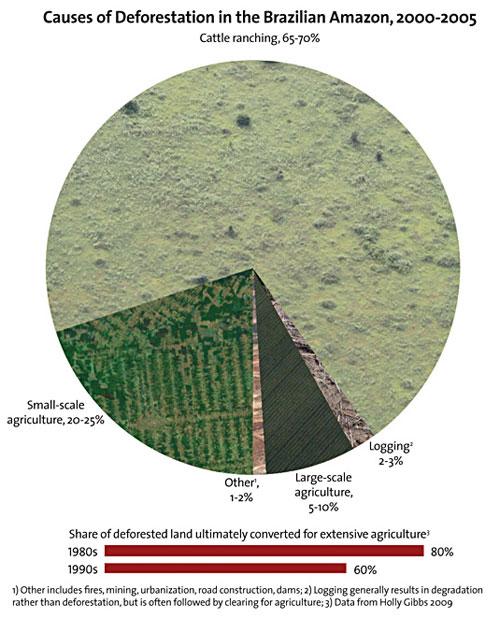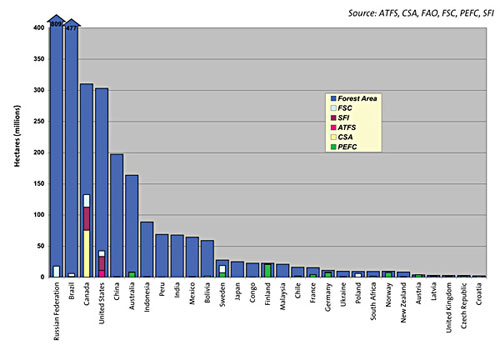Hardwoods in Green Building: Plantation-grown Eucalyptus Makes its Mark as a Versatile, Sustainable Exotic Species
Forest Certification Programs
Managed forests and plantations can help support sustainability goals, but not all managed forests or plantations are properly, or even legally, managed. According to the World Wildlife Fund, illegal logging practices result in the loss of nearly 36 million acres of natural forests across the world each year, an area roughly the size of New York State.
There is justifiably widespread concern about deforestation around the globe. Taking the Amazon basin as an example, 60 to 70 percent of deforestation comes from cattle ranching, and the rest from small scale subsistence. "Large-scale farming contributes relatively little to deforestation in the Amazon. And commercial forestry - logging followed by reforestation - is not deforestation," says Anderson. "However, studies do correlate unsustainable logging with future clearing for settlements and farming."
 |
Chart courtesy of Rhett A. Butler/mongabay.com |
Â
The immediate challenge, says Anderson, is to combat illegal harvesting, poor forestry practices and over-exploitation that lead to deforestation. In the U.S., recent changes to federal law make it illegal to import, export, sell, acquire or purchase illegal or illegally acquired plants, including any plant illegally harvested and illegally harvested wood or wood products. In 2008, Congress amended the Lacey Act with the Combat Illegal Logging Act that helps combat illegal logging and promotes fair trade for legally sourced wood. The Lacey Act defines illegal wood as wood taken in violation of relevant laws in the source country, and holds the importing entity responsible for avoiding illegal wood.
In the 1990s, concern over forest conservation prompted the establishment of several different sustainable forest management standards. The differences between these standards were, and to some extent still are, a function of their origins. They were founded by different interests and tailored to national differences in government regulation. Over time, however, business realities and societal expectations have narrowed the differences. Many observers maintain that all major certification systems are credible standards for sustainable forestry. All have third-party certification procedures that validate a participant's compliance with the requirements in standards that are controlled by independent boards and all have representation from environmental organizations, forest products companies, and the wider forestry community and represent the environmental, social, and economic values required for sustainable practices. Generally, sustainable forest management standards also set rules for documenting the source of wood used in a product and the conditions under which a product can carry a certified product label.
The labels of forest certification schemes are showing up on more and more products every year. Certification provides design professionals with the assurance that the wood comes from responsible sources. Several creditable organizations worldwide address the unique environmental aspects of forests in both temperate and tropical climates. In tropical areas, there are three prominent certifying bodies: the Forest Stewardship Council (FSC); Programme for the Endorsement of Forest Certification (PEFC), and the Brazilian Forest Certification Program (CERFLOR), which is endorsed by PEFC. FSC and PEFC are umbrella programs operating around the world, with regional certification schemes, including ones specific to tropical areas and distinct subregions therein.
All three, however, are voluntary programs. They are designed to promote sustainable forestry practices and include measures addressing water quality, wildlife habitat, and threatened and endangered ecosystems, and all three programs call for harvesting and regenerating forests at sustainable levels. Critical to certifying programs is the chain of custody system that tracks the amount of wood from certified forests flowing into a mill, and the amount of certified labeled products coming out. Chain of custody does not usually mean that a certain piece of wood comes from a certified forest, but it ensures that certification labels accurately reflect the volume of wood coming from sustainable forests. "Certification is especially critical when specifying tropical hardwoods since many developing countries have historically had illegal or unsustainable logging," says Anderson, noting that building professionals can have a significant influence on the situation by specifying only those wood products that have been independently certified as coming from sustainable forests.
 |
Certification by country |
Â
Yet even with this increase in promotion and demand for certified wood products, 90 percent of the world's forests have no certification at all - which makes it all the more important to source tropical wood that has been certified and/or comes from a company with operations that have been accredited to ISO 14001 standards.Â









